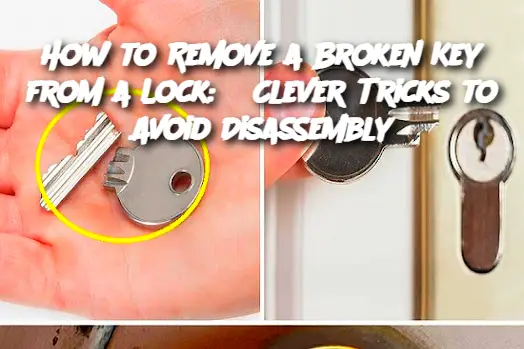ADVERTISEMENT
Introduction
Breaking a key inside a lock can be frustrating, especially if you don’t have the right tools on hand. Before resorting to disassembling the lock or calling a locksmith, try these five simple and effective methods to extract the broken key. With a bit of patience and the right technique, you can save yourself time and money.
Ingredients (Tools You'll Need)
Needle-nose pliers
Tweezers
Super glue (optional)
Lubricant (WD-40 or graphite powder)
A jigsaw blade or thin wire
A strong magnet (optional)
A key extractor tool (if available)
Instructions: 5 Ways to Remove a Broken Key from a Lock
1. Use Needle-Nose Pliers or Tweezers
If part of the key is sticking out of the lock, gently grip it with pliers or tweezers.
Carefully pull it out, making sure not to push the key further inside.
If the key doesn’t budge, try lubricating the lock before attempting again.
2. Apply Lubricant and Tap the Lock
Spray a lubricant (WD-40 or graphite powder) into the keyhole to reduce friction.
Insert a thin object (like a paperclip) alongside the broken key to wiggle it free.
Lightly tap the lock to encourage the key fragment to slide out.
3. Use a Jigsaw Blade or Thin Wire
Take a fine jigsaw blade or a thin, stiff wire and insert it alongside the broken key.
Try to hook the edge of the key and slowly pull it out.
This method works well for deep-seated broken keys.
4. Super Glue Trick (For Extreme Cases)
If part of the key is still visible, apply a tiny drop of super glue to the broken end.
Attach a thin object (like a toothpick or matchstick) to the exposed key part and wait a few seconds.
Once the glue sets, gently pull the key out.
Caution: Only use this method if the key is sticking out enough to grip; otherwise, you may accidentally glue the key deeper inside.
5. Use a Strong Magnet
If the key fragment is made of a magnetic material, try using a strong magnet to pull it out.
Move the magnet around the keyhole to see if the key shifts position.
This trick works best for small, lightweight key fragments.
Tips to Keep Your Lock in Good Condition
Regularly lubricate your locks to prevent keys from getting stuck.
Avoid using excessive force when turning a key, as this can cause breakage.
If your key shows signs of wear or cracks, replace it before it snaps.
Keep a spare key in case of emergencies.
Variations:
ADVERTISEMENT
